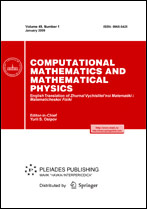|
|
Zhurnal Vychislitel'noi Matematiki i Matematicheskoi Fiziki, 1961, Volume 1, Number 2, Pages 196–207
(Mi zvmmf8012)
|
 |
|
 |
This article is cited in 1 scientific paper (total in 1 paper)
Contour series and their use in integral methods
I. V. Petukhov
Moscow
Abstract:
The importance of integral methods in the solution of non-linear equations in partial derivatives is widely acknowledged. These are methods based on the integral averaging of differential equations over small rectangles or thin strips into which the given region is split up (numerical methods) (see [1]) or over a whole region (approximate integral methods). In the latter case a certain number of contour connections between the derivatives of the required function on the boundary of the region is also taken into account. For example, in boundary layer theory there are approximate integral methods, such as the Karman–Pohlhausen method [2].
All these methods are based on the use of contour series. A contour series expresses the integral of a function in terms of its values and those of its derivatives at both ends of a given interval (or on the contour of a rectangle if a two-dimensional region is being discussed). The contour series determined in this way can be very varied. Below we shall be considering those which are used in the problem of expanding a function in series in terras of its averaged derivatives (in particular, Euler's series). The series that we shall discuss are in general asymptotic. However, their remainder terms are relatively small if the number of terms of the series is not large. The possible effectiveness of approximate integral methods, such as the Karman–Pohlhausen method, is essentially based on this property of contour series. We obtain an expression for the integral of the product of two functions in the form of a contour series. This series, together with the Euler series, is suitable for obtaining approximate expressions for the integral quantities occurring in the integral methods of boundary layer theory. The problem of expanding a function in series in terms of its averaged derivative is also considered for the case when the region over which the average is taken is a rectangle. Similar expressions are obtained in the form of double contour series for the corresponding (double) integrals of a function and of the derivative of functions.
The other question with which we shall be concerned is connected with the methods of numerical integration. If the region over which the average is taken is small, then these series of which only the first two terms are left, give a very exact estimate for the corresponding integral quantities and in some cases their use can eliminate the danger of the accumulation of errors associated with a large number of interpolation points. From this point of view the results we obtain can be used in those methods of numerical integration of non-linear partial differential equations (such as boundary layer equations) which are based on the previous integral averaging of the equations over the corresponding elementary regions.
Received: 28.10.1960
Citation:
I. V. Petukhov, “Contour series and their use in integral methods”, Zh. Vychisl. Mat. Mat. Fiz., 1:2 (1961), 196–207; U.S.S.R. Comput. Math. Math. Phys., 1:2 (1962), 214–227
Linking options:
https://www.mathnet.ru/eng/zvmmf8012 https://www.mathnet.ru/eng/zvmmf/v1/i2/p196
|


|





 Contact us:
Contact us: Terms of Use
Terms of Use
 Registration to the website
Registration to the website Logotypes
Logotypes








 Citation in format
Citation in format 
